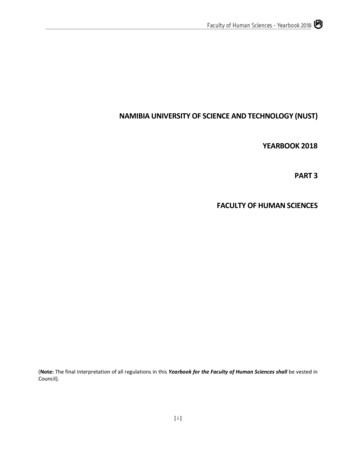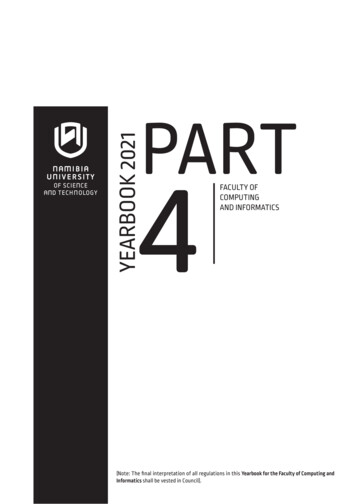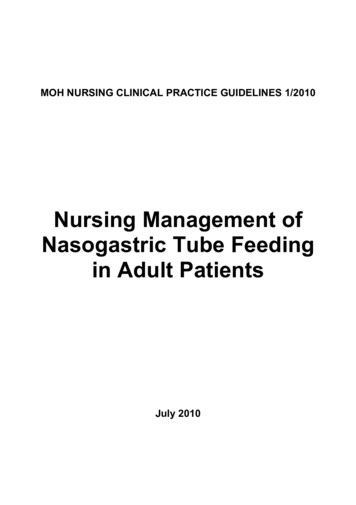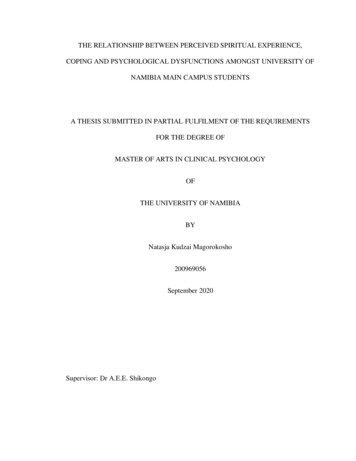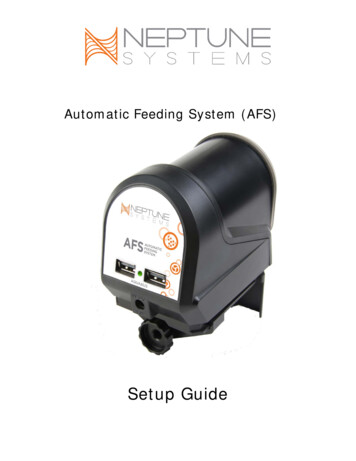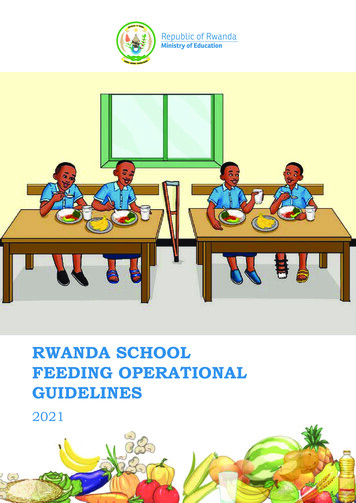
Transcription
Namibia SCHOOL FEEDING SABER Country Report2015 Policy GoalsStatus1. Policy Frameworks School feeding is mentioned in many of Namibia’s strategy documents and sectorial policies. A national school feeding policy in Namibia currently does not exist; however, there is a strong recognition for the need for such a policy. 2. Financial Capacity The national education budget includes a budget line for the Namibian School Feeding Programme (NSFP). The government contributes over 80 percent of the financial needs, while the remaining costs are covered by the community through cash and inͲkind contributions. NSFP budget plans/lines are at the central level only, and there is a strong need to put mechanisms in place to ensure the timely disbursement of funds. 3. Institutional Capacity and Coordination Currently, there is no steering committee in place to coordinate the implementation of NSFP in Namibia. The Ministry of Education (MOE) has the mandate of managing and implementing NSFP, and a specific unit within the MOE exists. There is insufficient staff to undertake the required functions for school feeding at both the national and regional levels. 4. Design and Implementation A comprehensive monitoring and evaluation plan and a webͲbased information system for NSFP were developed in collaboration with WFP in 2013. Beneficiary targeting criteria corresponds to the objectives of the program and the country’s needs, and is reflected in the NSFP Reference Manual. There are national standards for food distribution and the food basket in place for all NSFP benefiting schools. 5. Community Roles-Reaching Beyond Schools Each school has a functioning school board involving parents, teachers and community members. The expectations of communities and their respective roles and responsibilities are clearly defined in the NSFP Reference Manual. However, many communities feel the program relies too heavily on community contributions without proper incentives, which may contribute to a low level of participation. THE WORLD BANK
NAMIBIA ۣ SCHOOL FEEDING POLICIES Introduction This report presents an assessment of school feeding policies and institutions that affect young children in Namibia. The analysis is based on a World Bank tool developed as part of the Systems Approach for Better Education Results (SABER) initiative that aims to systematically evaluate education systems against evidenceͲbased global standards and good practice to help countries reform their education systems to help ensure learning for all. School feeding policies are a critical component of an effective education system, given that children's health and nutrition impacts their school attendance, ability to learn, and overall development. A school feeding program is a specific schoolͲbased health service, which can be part of a country’s broader school health program, and often a large amount of resources are invested in a school feeding program. SABERͲSchool Feeding collects, analyzes, and disseminates comprehensive information on school feeding policies around the world. The overall objective of the initiative is to help countries design effective policies to improve their education systems, facilitate comparative policy analysis, identify key areas to focus investment, and assist in disseminating good practice. Namibia in Brief Namibia is an arid southern African country with a population of 2.2 million people spread across 318,625 square miles.1 It is classified as an upperͲmiddleͲincome country; however, income inequality and structural poverty are still prevalent.2 The gross domestic product (GDP) of Namibia was 13.1 million USD. The economy is dependent on its natural resources and is vulnerable to natural disasters. After experiencing negative economic growth in 2009, Namibia’s economy experienced an average GDP growth rate of six percent between 2010 and 2013.3 GDP per capita increased from 6,155 USD in 2000 to 9,377 USD (constant 2011 international USD) in 2013. 4 While poverty in Namibia is declining, almost a third of the population is still considered poor.5 SABER COUNTRY REPORT 2014 Considering the economic condition of the country, chronic under nutrition is a prevailing issue; 24 percent of Namibian children are stunted and 8 percent are severely stunted. 6 Several strategies such as food assistance, remittances, and social grants have been established by the Government of the Republic of Namibia to assist the 16 percent severely and 22 percent moderately foodͲinsecure individuals and households in the country.7 These statistics indicate an important and continued need for foodͲbased safety net programs, such as the Namibian School Feeding Programme (NSFP). Education and Health in Namibia Following the country’s independence in 1990, the government placed a high priority on reducing inequalities by providing equal access to quality education for all children in Namibia. Article 20 of the Namibian Constitution (1990)8 declares that education is a basic universal right for all Namibians and made primary education free and compulsory for all children. The Education for All: National Plan of Action (2002Ͳ2015)9 further enshrines the government’s commitment to achieving universal education by outlining a strategy to improving access, equity, and quality in education. Formal education in Namibia is divided into four phases: Lower Primary (preͲprimary to grade 4), Upper Primary (grades 5Ͳ7), Junior Secondary (grades 8Ͳ10) and Senior Secondary (grades 11Ͳ12). In addition to the formal education system, the government also established the Namibia College of Open Learning to provide educational opportunities for adults and outͲofͲschool youth.10 Early childhood development centres are under the management of the Ministry of Gender Equality and Child Welfare, which targets children 5 years old and younger. The Ministry has the mandate to oversee the development of various aspects of early childhood 1627 Namibia Statistic Agency, 2013. Republic of Namibia, 2012a. 3 World Bank, 2014. 4 Ibid. 5 Namibia Statistic Agency, 2013. SYSTEMS APPROACH FOR BETTER EDUCATION RESULTS Republic of Namibia, 2013a. Republic of Namibia, 2013b. 8 Republic of Namibia, 1990. 9 Republic of Namibia, 2002. 10 Republic of Namibia, 2002. 2
NAMIBIA ۣ SCHOOL FEEDING POLICIES development, care, and education as well as issues that affect orphans and other vulnerable children (OVCs).11 Education in Namibia is a top priority and received 22.4 percent of the national annual budget in the 2012/13 fiscal year—the highest of any sector in Namibia. 12 Primary school net enrolment rate is at 99.8 percent, with gender parity at all grades.13 Literacy rates are high compared to regional standards: 95 percent for 15 to 24ͲyearͲolds and 88 percent for individuals 15 years old and older. However, the promotion rate for primary grades is 82 percent and 69 percent for secondary grades. A concern facing the education sector in Namibia is the high proportion of learners repeating grades—about 15 percent for primary and 22 percent for secondary learners. 14 The secondary school completion rate (47 percent) is quite low compared to countries with similar economic conditions. The government recognizes the importance of quality primary education on positively influencing the country’s economic and health indicators. Several strategies are in place to strengthen the education sector in Namibia. Health is another top priority for the Government of Namibia. Although access to health care has improved, the health care system still faces several challenges. First, rural and urban residents have unequal access to infrastructure and services. In 2012, only 17 percent of the rural population had access to improved sanitation facilities compared to 56 percent of the urban population. The gap in access to an improved water source is smaller with 87 percent of the rural population having access to an improved water source in 2012 compared to 98 percent of the urban population. 15 Access to clean water and sanitation facilities can improve health outcomes. Other health challenges include the high burden of communicable diseases. In 2012, approximately 47 percent of deaths were caused by either communicable diseases or poor maternal, prenatal, and nutrition 11 Ibid. UNESCO, 2014. 13 Republic of Namibia, 2012b. 14 Ibid. 15 World Bank, 2014. 16 Ibid. 17 Ibid. 12 SYSTEMS APPROACH FOR BETTER EDUCATION RESULTS SABER COUNTRY REPORT 2014 conditions. Communicable diseases in Namibia include HIV, tuberculosis, and malaria. Namibia has one of the highest rates of HIV globally. The prevalence of HIV amongst individuals between the ages of 15Ͳ49 has gradually declined from 17 percent in 2003 to 14 percent in 2013.16 However, the reported number of tuberculosis cases has increased within the same time period. NonͲcommunicable diseases, such as hypertension and diabetes, are also becoming a problem. In 2012, approximately 43 percent of deaths were caused by nonͲcommunicable diseases.17 The maternal mortality ratio and infant mortality rate have not made significant improvements since 2000. The maternal mortality ratio increased from 225 deaths per 100,000 live births in 1992 to 449 deaths in 2007 mainly due to HIV/AIDS and the lack of access to emergency obstetric care services. 18 Infant mortality rates have decreased slowly. In 2013, the infant mortality rate was 35.2 per 1,000 live births, which is a slight decrease from the previous year. The neonatal mortality rate remained steady at 21.8 deaths per 1,000 live births from 2012 to 2013. The underͲ5 mortality rate decreased very slowly between 2010 and 2013, with rates of 56 deaths and 50 deaths per 1,000 live births respectively.19 Nutrition is a priority and a multiͲsectoral implementation strategy was developed in 2012 to address stunting in children under the age of five years old. Approximately 29 percent of children under five are stunted, which may make them more susceptible to disease and have a negative effect on cognitive development. 20 Micronutrient deficiency is also a problem with the highest rate of anemia amongst preschoolͲaged children and several regions with populations that are iodine deficient.21 The Case for School Feeding School feeding programs, defined here as the provision of food to schoolchildren, can increase school enrollment 22 and attendance—especially for girls. 23 When combined with quality education, school feeding 18World Health Organization and Republic of Namibia’s Ministry of Health and Social Services, 2010. 19 World Bank, 2014. 20 Namibia Alliance for Improved Nutrition, 2013. 21 Ibid. 22 Ahmed, 2004; Gelli, Meir, and Espejo, 2007. 23 Jacoby, Cueto, and Pollitt, 1996; Powell et al., 1998; Kristjansson et al., 2007. 3
NAMIBIA ۣ SCHOOL FEEDING POLICIES programs can increase cognition 24 and educational success. 25 With appropriately designed rations, school feeding programs can improve the nutrition status of preschoolͲ and primary schoolͲaged children by addressing micronutrient deficiencies. Combined with local agricultural production, these programs can also provide smallͲscale farmers with a stable market. School feeding programs can provide shortͲterm benefits after crises, helping communities recover and build resilience, in addition to longͲterm benefits by developing human capital.26 School feeding programs can be classified into two main groups: inͲschool feeding (when children are fed in school) and takeͲhome rations (when families are given food if their children attend school regularly). A major advantage of school feeding programs is they offer the greatest benefit to the poorest children. Several studies 27 have indicated that missing breakfast impairs educational performance. Present data suggests that almost every country is seeking to provide food to its schoolchildren. Therefore, especially for lowͲincome countries where most foodͲinsecure regions are concentrated, the key issue is not whether a country will implement schoolͲfeeding programs but rather how and with what objectives. Social shocks of recent global crises led to an enhanced demand for school feeding programs in lowͲincome countries as they can serve as a safety net for foodͲinsecure households through an income transfer. In response to this amplified request, the United Nations World Food Programme (WFP) and the World Bank jointly undertook an analysis titled Rethinking School Feeding. 28 This initiative sought to better understand how to develop and implement effective school feeding programs as a productive safety net that is part of the response to the social shocks, as well as a fiscally sustainable investment in human capital. These efforts are part of a longͲterm global goal to achieve Education For All and provide social protection to the poor. The Government of Namibia took ownership of the Namibian School Feeding Programme (NSFP) from the United Nations World Food Programme (WFP) in 1996; SABER COUNTRY REPORT 2014 the government has fully funded and managed the program since then.29 NSFP has grown into an important strategy that the government utilizes to increase educational opportunities for vulnerable children; increase attendance, retention, and promotion rates; and to provide a safety net to foodͲinsecure students.30 NSFP provides a daily midͲmorning meal of fortified maize meal to approximately 320,000 preͲprimary and primary school children in vulnerable areas throughout all 14 regions in Namibia. The Directorate of Programmes and Quality Assurance (PQA), under the Ministry of Education, is the formal government body that coordinates, manages, and implements the school feeding program in Namibia. The NSFP unit’s main functions include food procurement, monitoring implementation, and maintaining oversight and external control of the feeding program. In 2012, the Ministry of Education (MOE) conducted an operational review on NSFP, with technical assistance from WFP. The resulting NSFP Case Study 31 revealed significant gaps and challenges that threatened the quality of school feeding in Namibia. In an effort to improve the effectiveness of the program, the MOE established a strategic partnership with WFP to get technical support in four main areas: policy guidance, capacity building and program support, knowledge generation, and management and system strengthening. There are five core policy goals that form the basis of an effective school feeding program. Figure 1 illustrates these policy goals and outlines respective policy levers and outcomes that fall under each goal. The first goal is a national policy framework. A solid policy foundation strengthens a school feeding program’s sustainability and quality of implementation. National planning for school feeding as part of the country’s poverty reduction strategy (or other equivalent development strategies) conveys the importance the government places on school feeding as part of its development agenda. For most countries that are 24282529 Whaley et al., 2003; Kristjansson et al., 2007; Jukes et al., 2008. Tan, Lane, and Lassibille, 1999; Ahmed, 2004; Adelman et al., 2008. 26 WFP, 2013 27 Simeon and GranthamͲMcGregor, 1989; Pollitt, Cueto, and Jacoby, 1998; Simeon, 1998. SYSTEMS APPROACH FOR BETTER EDUCATION RESULTS Bundy et al., 2009. Republic of Namibia, 2012a. 30 Ibid. 31 Ibid. 4
NAMIBIA ۣ SCHOOL FEEDING POLICIES implementing their own national programs, school feeding is included in national policy frameworks.32 The second policy goal for school feeding is financial capacity. Stable funding is a prerequisite for sustainability. However, where need is greatest, programs tend to be the smallest and the most reliant on external support. Funding for these programs can come from a combination of sources, such as nonͲgovernmental organizations (i.e., WFP) and the government. When a program becomes nationalized, it needs a stable and independent funding source, either through government core resources or development funding. In the long term, a national budget line for school feeding is necessary for an effective and stable program. The third policy goal is institutional capacity and coordination. School feeding programs are better executed when an institution is mandated and accountable for the implementation of such a program. Effective programs also include multiͲsectoral involvement from sectors such as education, health, agriculture, and local government, as well as a comprehensive link between school feeding and other school health or social protection programs and established coordination mechanisms. The fourth policy goal is sound design and implementation. In order to maximize effectiveness, school feeding programs should clearly identify countryͲspecific problems, objectives, and expected outcomes. The country’s context and needs should determine the program’s beneficiaries, food basket (menus), food modalities and supply chain. Countries and partners should work towards creating a delicate balance among international, national, and local procurement of foods to support local economies without jeopardizing the quality and stability of the food supply. The last policy goal is community rolesͲreaching beyond schools. School feeding programs that are locally owned, incorporate contributions from local communities, and respond to specific community needs are often the strongest. These programs are most likely to make a successful transition from donor assistance to national ownership. Community participation should be SABER COUNTRY REPORT 2014 considered at every stage, but without overburdening community members. Ǧ The primary focus of the SABERͲSchool Feeding exercise is gathering systematic and verifiable information about the quality of a country’s policies through a SABERͲSchool Feeding Questionnaire. This dataͲcollecting instrument helps to facilitate comparative policy analysis, identify key areas to focus investment, and disseminate good practice and knowledge sharing. This holistic and integrated assessment of how the overall policy in a country affects young children’s development is categorized into one of the following stages, representing the varying levels of policy development that exist among different dimensions of school feeding: 1. Latent: No or very little policy development 2. Emerging: Initial/some initiatives towards policy development. 3. Established: Some policy development 4. Advanced: Development of a comprehensive policy framework Each policy goal and lever of school feeding is methodically benchmarked through two SABER analysis tools. The first is a scoring rubric that quantifies the responses to selected questions from the SABER School Feeding questionnaire by assigning point values to the answers. The second tool is the SABER School Feeding Framework rubric that analyzes the responses, especially the written answers, based on the framework’s five policy goals and levers. For more information, please visit the World Bank’s website on SABERͲSchool Health and School Feeding and click on the “What Matters” Framework Paper under Methodology. 32 Bundy et al., 2009; WFP, 2012. SYSTEMS APPROACH FOR BETTER EDUCATION RESULTS 5
NAMIBIA ۣ SCHOOL FEEDING POLICIES SABER COUNTRY REPORT 2014 Figure 1: Policy goals and policy levers for school feeding SYSTEMS APPROACH FOR BETTER EDUCATION RESULTS 6
NAMIBIA ۣ SCHOOL FEEDING POLICIES SABER COUNTRY REPORT 2014 1. Policy Frameworks is EMERGING Findings Indicators1A. NationalͲlevel poverty reduction strategy as well as education sectoral policies and strategies identify school feeding as an education and/or social protection intervention, with clearly defined objectives and sectoral responsibilities 1B. An evidenceͲbased technical policy related to school feeding outlines the objectives, rationale, scope, design, and funding and sustainability of the program and comprehensively addresses all four other policy goals. Policy Goal 1: Policy Frameworks in Namibia Policy Lever xOverarching policies for school feeding in alignment with nationalͲlevel policy A policy foundation helps strengthen the sustainability and accountability of a school feeding program as well as the quality of its implementation. Nearly all countries with national ownership of programs have wellͲarticulated national policies on the modalities and objectives of school feeding.33 The recognition of the Namibian School Feeding Programme (NSFP) as an important safety net is demonstrated by the inclusion of the program in seven national strategy documents and sectoral policies/plans, including Namibia's Fourth Development Plan (NDP4) for 2012/13Ͳ2016/17, 34 Education and Training Sector Improvement Plan (ETSIP) in 2005, 35 Education for All Policy (EFA) for 2002Ͳ2015,36 National Plan of Action for OVCs in 2006, 37 National Policy for School Health in 2008,38 National Drought Policy & Strategy in 1997,39 and the National Policy on HIV/AIDS for the Education Sector in 2003.40 The National Strategic Plan for Nutrition also states that the Ministry of Education oversees the quality and safety of the food served for the school feeding programme. 41 However, a separate national policy on school feeding in Namibia is not yet in place. The Ministry of Education is partnering with WFP to begin work on developing a NSFP policy. Score JustificationSchool feeding included in PRSP and Education Sector Plan; but without targets, strategies, defined objectives and sectoral responsibilities. A national policy on school feeding is not developed; however there is a strong recognition of its importance and it is listed in the NSFP 5Ͳyear Road Map (2012Ͳ2017) as a milestone and action item. 33383439 WFP, 2012 Republic of Namibia, 2012c. 35 Republic of Namibia, 2005. 36 Republic of Namibia, 2002. Pg. 38 37 Republic of Namibia, 2006. SYSTEMS APPROACH FOR BETTER EDUCATION RESULTS Republic of Namibia, 2008. Pg. 6 Republic of Namibia, 1997. 40 Republic of Namibia, 2003. Pg. 5 41 Republic of Namibia, 2011. Pg. 46. 7
NAMIBIA ۣ SCHOOL FEEDING POLICIES Policy Goal 2: Financial Capacity in Namibia Policy Lever xGovernance of the national school feeding program through stable funding and budgeting Stable funding is necessary for the longͲterm sustainability of a school feeding program, especially one that transitions from being donorͲfunded to governmentͲfunded. School feeding programs supported by external partners generally rely on food aid, government inͲkind donations, and/or government cash contributions. In order for the program to be sustainable and nationally owned, the school feeding program should have a budget line and be part of the government’s budgeting and planning process. The budget for the Namibian School Feeding Programme (NSFP) is incorporated within the national education budget. It is listed under ‘Other Services’ (item 027), 42 which also includes catering, workshops, training, publishing, etc. While NSFP technically has its own budget line, it is not listed under programs, which limits its sustainability and recognition as an integral intervention for quality learning. The Ministry of Education’s goal is to list NSFP separately as a program line item under Primary Education and Secondary Education, as the beneficiary target group expands. The current budget for NSFP mainly covers the purchase and distribution of food/maize blend (98 percent). The remaining 2 percent covers the cost of staff and the overall management of NSFP, which is considered very low in comparison with other countries. This leaves no funds available for nonͲfood items or infrastructure needs (i.e., adequate storage places, kitchens, stoves, pots, and utensils). The government contributes over 80 percent of the financial needs for the school feeding program, while the remaining costs are covered through community contributions, most of which are inͲkind. As the budget priority is procuring food, the limited budget remains a constraint against diversifying the food basket, SABER COUNTRY REPORT 2014 expanding the staffing capacity, and incorporating additional monitoring activities. From 2011Ͳ2014, the Global Fund to Fight AIDS, TB and Malaria financed the NSFP food needs (maize meal) for only two regions with a high population of the San people, specifically Kunene and Otjozondjupa. 43 They contributed approximately 123,810 USD, which was one percent of investment in school feeding. The provision of funds ended in 2013/2104. Regions and schools do not have a dedicated budget line for NSFP, nor do they budget for NSFP activities. Some schools do make provision under the School Development Fund or Universal Primary Education Fund for NSFP expenses. A few regions have begun to incorporate NSFP activities within the regional education budget, although this is not standardized. Previously, late release of funds to service providers has caused delayed delivery of food to schools, threatening the impact and the integrity of the program. There is a strong need to put mechanisms in place to ensure the disbursement of funds to school feeding implementers in a timely and effective manner. 2. Financial Capacity is EMERGING Indicators2A. National budget line(s) and funding is allocated to school feeding; funds are disbursed to the implementation levels in a timely and effective manner. Score JustificationThe Namibian School Feeding Programme is funded from a central government budget. Funds are not enough to cover all the needs. There is no budget line for school feeding in the regional and school levels. There is a need to put mechanisms in place to ensure the disbursement of funds for school feeding implementers in a timely and effective manner. 42 Republic of Namibia, 2012a. pg. 57 The ‘San’ people are group of former hunterͲgatherer communities that are made up of different ethnic groups. The San population has the highest level 43 SYSTEMS APPROACH FOR BETTER EDUCATION RESULTS of poverty than any other ethnic/tribal group in Namibia, and several interventions and strategies are targeted to the San community, especially programmes around increasing educational outcomes for San learners. 8
NAMIBIA ۣ SCHOOL FEEDING POLICIES Policy Goal 3: Institutional Capacity and Coordination in Namibia Policy Levers xxSchool feeding interͲsectoral coordination and strong partnerships Management and accountability structures, strong institutional frameworks, and monitoring and evaluation Implementing a school feeding policy requires significant institutional capacity because the program is a complex school health intervention. The policy should clearly define the roles and responsibilities of stakeholders and actors at all levels. Methodically increasing government capacity to manage a school feeding program is important to the program’s longͲterm sustainability. A national institution that is mandated and accountable for the implementation of the school feeding program is considered to be a best practice. This institution should have a specific unit that has adequate resources and knowledgeable staff to manage the school feeding program. Moreover, policies that detail accountability and management mechanisms can help ensure program quality and efficiency, especially if the school feeding program is decentralized. Currently, Namibia does not have a steering committee in place that coordinates the implementation of the Namibian School Feeding Programme (NSFP). The Ministry of Education (MOE) has the mandate of implementing the school feeding program to preschools and primary schools in Namibia. Under the MOE, the Directorate of Programmes and Quality Assurance (PQA) is responsible for the oversight of NSFP; however, the mai
program is a specific school rbased health service, which can be part of a country's broader school health program, and often a large amount of resources are invested in a school feeding program. SABER rSchool Feeding collects, analyzes, and disseminates comprehensive information on school feeding policies around the world. The overall
